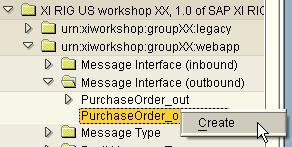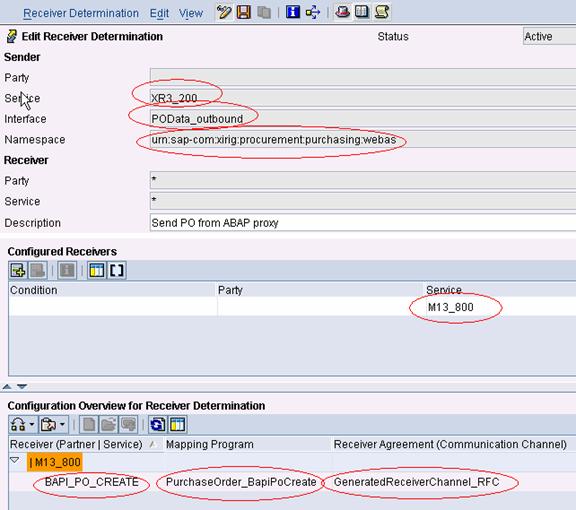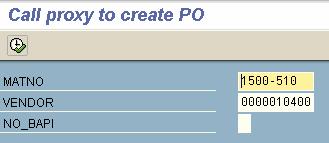
| |
| SAP NETWEAVER |
| SAP XI |
| SAP EP |
| SAP MDM |
| SAP BI |
| SAP WAS |
| SAP KM |
| SAP MI |
| SAP NETWEAVER 2004S |
| SAP NETWEAVER 2004 |
Welcome to SAPAG.CO.IN
|
|
SAP AG.co in Will Give information of SAP related meterials Like SAP Platform and Operation,,SAP Security , SAP Enterprise Portal (EP), ,SAP Knowledge Management (KW), SAP Business Intelligence (BI), Exchange Infrastructure (XI),Application Server, Mobile (MI), Master Data Management MDM, Composit Appications Frame work,Web Dynpros,OOPABAP,Blog,Intergration Bulder, Integration Repository (IB),Integration Directory (ID).System Landscape Directory (SLD), And Adopter Configuration like File to File,File to JDBC, File to IDoc, File Content Convertion, RFC, HTTP,SOAP,XI Interview Questions,Xi Sertification Questions, and many more about SAP Netweaver Platform XI Training And Tutorial and XI interview Questions ..
SAP Exchange Infrastructure Tutorials
SAP XI Exercises – Proxy to BAPI
Overview
This exercise introduces the generation and execution of ABAP proxies in a Web Application Server 6.40 or above. We will demonstrate the reusability of objects in the XI Repository, and emphasize the outside-in approach for interface development, offered by XI.
 Prerequisites
Prerequisites
• Good understanding of basic XI 3.0 features
• Basic knowledge of ABAP-OO programming
Description
This is similar to the previous exercise, where the plain HTTP client was used to post XML data to XI, first synchronously then asynchronously. In this case, instead of an HTTP client, an ABAP program will send the message via the proxy framework. The assumption, of course, is that there is a client available in a SAP WebAS 6.40 or above for this purpose.
The instructor will explain the outside-in development approach which is a fundamental concept behind SAP Exchange Infrastructure. We will fully re-use the existing Repository objects and generate a synchronous proxy in the ABAP client. During this process we will deal with naming conflicts for the generated proxy, and learn how to address them. Then we will explore the ABAP proxy runtime and send a message from an application program.
Exercise steps
Step 1 – Repository
Since we are re–using the PO-related objects created in the previous exercise, nothing needs to be done in the Integration Repository.
Step 2 – ABAP client
• Generate an outbound synchronous proxy for your message interface “PurchaseOrder_out”
• Log on to the SAP Web AS 6.40 client available for this workshop (ask instructor for details).
• Enter transaction SPROXY. In the list of Software Components, expand your own Software Component. Right–click on the interface name, ‘PurchaseOrder_out”, and click on “Create”.

• A window will pop up to allow entries for Package Name and Prefix. Enter the following:
• Package: $TMP
• Prefix: ZGROUP[XX]. Please use individual prefix!

• When generating the proxy, you may get a warning message regarding naming problems. You will have to select the tab ‘Name Problems' and examine the situation. The names of the ABAP proxy objects are limited to 30 characters. Because of the prefix and the long names for the repository objects, the system has truncated them, which in turn led to duplicates.
• Resolve the naming conflicts, using the uggested values below:
ABAP Name |
Name in Integration Builder |
ZGROUPXXCO_PURCHASE_ORDER_OUT |
PurchaseOrder_out |
ZGROUPXXPO_OUT_HEADER |
header |
ZGROUPXXPO_OUT_ITEM |
item |
ZGROUPXXPO_OUT_POREQUEST |
PurchaseOrderRequest |
ZGROUPXXPO_OUT_PORESPONSE |
PurchaseOrderResponse |
ZGROUPXXPO_OUT_RECORDSET |
Recordset |
ZGROUPXXPO_OUT_RETURN |
Return |
ZGROUPXXPO_OUT_RECORDSET_TAB |
Recordset (table type) |
ZGROUPXXPO_OUT_RETURN_TAB |
Return (table type) |
ZGROUPXXPO_OUT_ITEM_TAB |
Item (table type) |
• Examine the rest of the ABAP class and generated DDIC objects. Then, save and activate your proxy (ignore warnings about reserver fields “key” and “return”.)
• There is nothing more to be done with the proxy. The classes and structures generated for an outbound proxy cannot be changed. They can only be referenced and executed. To execute the proxy, we will write an ABAP report. This will be presented in a later step.
Step 3 – Directory
The Integration Directory configuration steps should be identical to Exercise 2, the only exception is the sender information. In this case the Sender Service name should be the Business System of the WebAS system defined in the System Landscape Directory.

Step 4 – Test
To test the ABAP proxy, we will use an ABAP report.
• In SAPGUI, use transaction SE38 and create an ABAP report, with the name: Z_XIWS_[XX]_SEND_PO
• Examine file “Z_XIWS_XX_SEND_PO.abap”, provided to you. In the type definition section, adjust the type names according to your own proxy types in the system. Replace all occurrences of [XX] with your group number.
• In transaction SE38, create a report with the same name “Z_XIWS_[XX]_SEND_PO” (type: executable program). Assign the program to package $TMP (local object). Cut and paste the contents of your file into the source code area.
• Perform a syntax check. Save and activate the report.
• Execute/test the report. Change the vendor to your assigned vendor id.
 • In transaction SXMB_MONI, you can view the status of the message. Notice that you see 4 entries for your message, representing the request and response in integration engine:
• In transaction SXMB_MONI, you can view the status of the message. Notice that you see 4 entries for your message, representing the request and response in integration engine:
• Integration Engine located in the main integration server client
• Integration Engine located in the application client where the proxy resides.
Step 5 – Optional
For additional practice, generate and run an outbound asynchronous proxy for interface based on the asynchronous interface used in the exercise 1.
Appendix: naming conventions and terminology
Exercise 4
Area |
Obj. type |
Object name |
Description |
SLD |
n/a |
n/a |
No SLD objects |
Int. Rep. |
NS |
urn:xiworkshop:groupXX[00..30]:webapp |
All objects same as exercise 2 |
|
XSD |
PurchaseOrderCombined |
|
|
Msg.type |
PurchaseOrderRequest |
|
|
Msg.type |
PurchaseOrderResponse |
|
|
Msg.int. |
PurchaseOrder_out |
|
|
Msg.int. |
PurchaseOrder_out_async |
|
|
XSLT |
POReq__Z_BAPI_PO_CREATE_req.xsl |
|
|
XSLT |
ZBAPI_PO_CREATE_resp__POResp.xsl |
|
|
Archive |
PurchaseOrder__Z_BAPI_PO_CREATE |
|
|
Int.map |
PO_out__Z_BAPI_PO_CREATE |
|
|
Int.map. |
PO_out_async__Z_BAPI_PO_CREATE |
|
|
Context |
Vendor |
|
Int. Dir |
scenario |
xiworkshop_groupXX[00..30] |
Reuse scenario container |
|
service |
XIWS_web_purchasing_XX |
Business service – no party |
640-cli |
Prefix |
ZGROUPXX |
Prefix for proxy objects |
|
proxy |
ZGROUPXXCO_PURCHASE_ORDER_OUT |
PurchaseOrder_out |
|
|
ZGROUPXXPO_OUT_HEADER |
header |
|
|
ZGROUPXXPO_OUT_ITEM |
item |
|
|
ZGROUPXXPO_OUT_POREQUEST |
PurchaseOrderRequest |
|
|
ZGROUPXXPO_OUT_PORESPONSE |
PurchaseOrderResponse |
|
|
ZGROUPXXPO_OUT_RECORDSET |
Recordset |
|
|
ZGROUPXXPO_OUT_RETURN |
Return |
|
|
ZGROUPXXPO_OUT_RECORDSET_TAB |
Recordset (table type) |
|
|
ZGROUPXXPO_OUT_RETURN_TAB |
Return (table type) |
|
|
ZGROUPXXPO_OUT_ITEM_TAB |
Item (table type) |
|
Program |
Z_XIWS_[XX]_SEND_PO |
Program for testing the proxy |
File sys |
Program |
Z_XIWS_XX_SEND_PO.abap |
Source code template for program |
R/3 |
RFC |
ZBAPI_PO_CREATE |
RFC wrapper |
| Latest SAP Netweaveer Books | ||
|
|
||